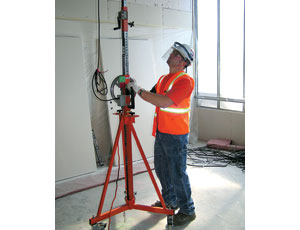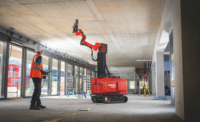Researchers have developed an “inverted” drill press that cuts by nearly 90% the stress overhead drilling puts on shoulders, arms and hands.

Led by Dr. David Rempel, a University of California medicine and bioengineering professor, and funded through national labor and safety grants, researchers recently tested the device with craft workers in California, Oregon and Washington. Testers drilled overhead holes using a hammer drill and then the drill press. The hammer drill required workers to reach overhead and push upward with 55 lb of force; the hand-wheel-operated press took only 5.8 lb, a reduction of 89.5%.
The drill press consists of a tripod base, a telescoping column with a drill-mounting saddle on top, and gears that extend and retract the column. It weighs about 45 lb and reportedly can be assembled on-site in about 30 seconds.
No manufacturer has yet signed up to produce the press. However, Cupertino Electric, an electrical contractor in San Francisco, helped test the device and has built several units for its crews to use. It plans to build up to 20 more.
“The device works well for standard deck heights of 12 ft to 14 ft. Drilling production runs about even with the traditional method,” says Eric Abbott, Cupertino general superintendent. “One key to using it effectively is planning construction so there are no obstructions between the floor and the drilling area overhead.” Each press costs about $1,000 in parts and $3,000 in labor to build. Researchers are looking at developing an inverted press for highway bridges and overpasses.


Post a comment to this article
Report Abusive Comment